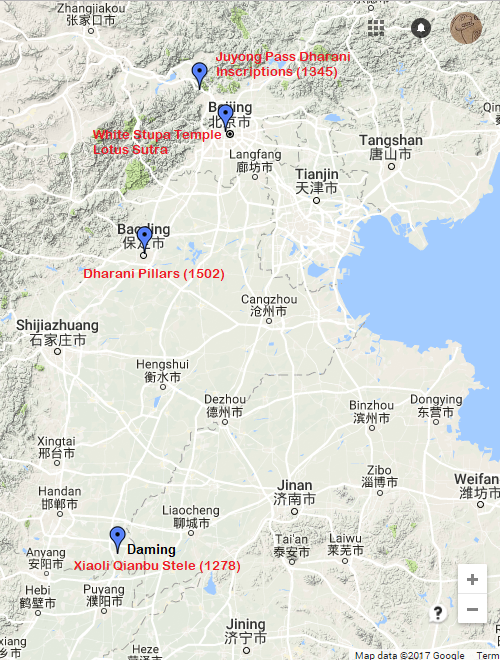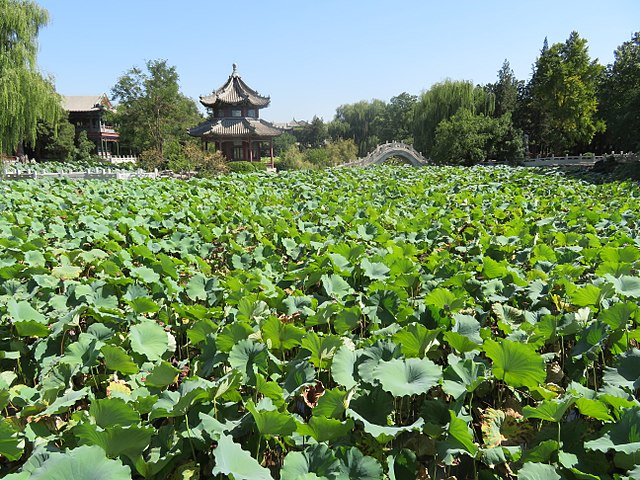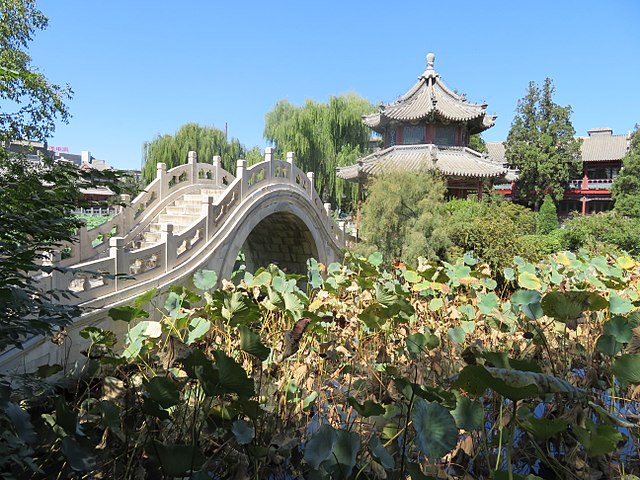Diary of a Rambling Antiquarian
Tuesday, 19 September 2017
Ancient Lotus Pond Revisited
In December 2013 I took a trip to the Ancient Lotus Pond (Gǔ Liánhuā Chí 古蓮花池) in Baoding in order to see the latest surviving relics of the Tangut script, a pair of Ming dynasty dharani pillars dated 1502. I have decided to revisit Baoding so that I can take additional photographs of the Tangut dharani pillars because some of the Tangut characters were not clear in my original photographs.
In 2013 we drove down to Baoding from Beijing by car, which took 3½ hours. This time I go by high-speed train from Beijing West station to Baoding East station, which takes a mere 40 minutes (and then 30 minutes by taxi to the Ancient Lotus Pond).
Entrance ticket for the Ancient Lotus Pond
Different size and style compared with the 2013 entrance ticket
I started the morning with a lightning visit to the White Stupa of Miaoying Temple, which as I mentioned probably housed some Tangut monks during the Yuan dynasty as six volumes of Tangut Buddhist sutras were discovered there in 1900. The Tangut dharani pillars now located in the grounds of the Ancient Lotus Pond were discovered in 1962 on the site of a Buddhist temple in what was then the northern suburbs of Baoding. This temple, thought to be the Temple for Promoting Goodness (Xīngshàn Sì 興善寺) mentioned in local gazetteers, obviously housed a contingent of Tangut monks up to at least the early 16th century, and like Miaoying Temple it had a white stupa (although on a smaller scale). Sadly the temple and its white stupa were burnt to the ground in 1900, in the aftermath of the Boxer Rebellion, by the forces of the Eight Nation Alliance, and any Tangut scriptures that might have survived in the temple library were destroyed.*
* Corrigendum. The Tangut Buddhist sutras were actually discovered at Beijing's other White Stupa in Beihai Park. See my discussion at Rediscovery of a Lost Tangut Manuscript (2018-04-15).
Although we often think of the Mongols as having annihilated the Tangut people and destroyed their culture and language, it is clear from historical sources and from sites such as Baoding that communities of Tangut monks and laypeople lived in Northern China during the Yuan dynasty and later. Examples of Tangut writing dating from the 13th through 16th centuries have been found at four sites in Northern China:
- Tangut manuscript copy of the Lotus Sutra (Saddharma Puṇḍarīka = 𗤓𗹙𗤻𗑗𗖰𗚩) at Miaoying Temple (White Stupa Temple) in Beijing. [See corrigendum above.]
- A commemorative stele for the Tangut official Xiaoli Qianbu (小李鈐部 = 𗼽𘝾𘒏𗩈), with the name of him and his wife engraved in Tangut script, found at his tomb on the western outskirts of Daming (1278).
- Tangut versions of the Dharani-Sutra of the Victorious Buddha-Crown (Uṣṇīṣa-vijaya-dhāraṇī-sūtra = 佛頂尊勝陀羅尼經) and Dharani-Sutra of the Tathagata Heart (Tathāgata-hṛdaya-dhāraṇī-sūtra = 如來心陀羅尼經) carved on the inside walls of the Cloud Platform at Juyong Pass northwest of Beijing (c. 1345).
- Two dharani pillars engraved with the Tangut version of the Dharani-Sutra of the Victorious Buddha-Crown (Uṣṇīṣa-vijaya-dhāraṇī-sūtra = 佛頂尊勝陀羅尼經) at Baoding (1502).
Map of Hebei and Beijing showing Tangut Sites
{Map data ©2017 Google}
I have been to three of these four sites, and considered going to Daming to see the Stele of Xiaoli Qianbu today instead of coming here to Baoding, but as Daming is not on a railway line it is not practical to go there for a day trip from Beijing, and I don't even know whether the stele is on display in the local museum or not. So here I am at the Ancient Lotus Pond in Baoding again. The pond which four years ago was cold and empty is now lush with lotus plants, even though their summer flowers have already wilted, but otherwise there is little change from the last time I was here.
The Ancient Lotus Pond in Baoding in Early Autumn
Bridge over the Ancient Lotus Pond
But I am not here to admire the lotus plants, and after a quick perambulation of the pond I make my way to the Courtyard of Steles where I spend nearly an hour uninterrupted taking photos of the inscriptions on the two dharani pillars and the neighbouring 1350 Chinese stele for the Tangut official Laosuo. My photography is only brought to a conclusion when I inadvertantly trigger a sensor by the gateway through the painted balutrades, and a guard comes to investigate. I had taken enough photos by then anyway, so I apologised and left.
The Two Dharani Pillars and the Stele of Laosuo
Whilst waiting for a taxi to take me back to Baoding East station I took a photo of Baoding Cathedral, which is immediately opposite the entrance to the Ancient Lotus Pond. I have no doubt that there would have been Christians living in Baoding during the Yuan dynasty, as well as Tangut Buddhists, but they left no traces.
Cathedral of Saints Peter and Paul in Baoding
I arrive back at Beijing West station at 3:15 pm, and decide to try to go to the Beijing Liao and Jin City Wall Museum which is about 20 minutes fast walk from Beijing South station. I went there in August 2011 to take a photograph of the Khitan Small Script epitaph for Yelü Dilie (1026–1092), but the sun was shining on the epitaph stone, and the photograph was not good. I went there again in December 2013 to take a better photograph, but the museum was closed for repairs. That was four years ago, and I am sure the museum must have reopened by now. I arrive just before 5 pm, and find to my dismay that the museum is once again closed for repairs, and is not expected to reopen until May 2018. "Closed for repairs" seems to be a repeating motif haunting my trips to Beijing in both 2013 and 2017. Tomorrow I leave Beijing, travelling by train to Hohhot in Inner Mongolia.
Hebei | Ming dynasty | Tangut
Index of Rambling Antiquarian Blog Posts
Rambling Antiquarian on Google Maps





